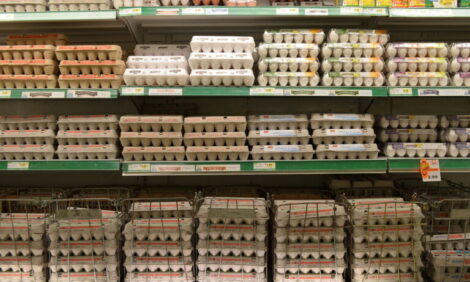



Is Gas Stunning as Humane as we Think?
Animal health authorities are researching ways to reduce unwanted side-effects of controlled-atmosphere stunning around the world. Glenneis Kriel investigates current concerns and how gas stunning might be improved to minimise the symptoms of discomfort.The primary mission of the Paris-based World Organisation for Animal Health (OIE) is to prevent the spread of livestock disease among its 180 member nations – but it is also constantly looking for ways to improve animal welfare worldwide.
*
The drawback is that gas stunning does not induce instantaneous insensibility, which raises the question: how much stress and discomfort does the animal undergo before it loses consciousness?
When it comes to gas stunning, the process by which gases such as carbon dioxide or nitrogen are used to render the animals unconscious prior to slaughter, its main focus is on addressing side-effects which could be signs of unnecessary suffering.
Dr Moetapele Letshwenyo, OIE Sub-Regional Representative for Southern Africa, whose office monitors animal health across 15 African nations, said the OIE does not have a problem with gas stunning if done properly. While this is the case in general, poor implementation has become associated with negative side-effects. In the case of birds, these can include head shaking, flapping of wings, convulsions and gasping.
Some ways of implementing gas stunning are better than others, Dr Letshwenyo explained. Gassing is more uniform when birds are subjected to the gas all at once, such as when they are lowered into the gas on a lift or elevator. When the birds are moved into the gas on a conveyor belt, the birds at the front often inhale more gas than those at the back of the container.
“The speed at which the birds are managed from when they are delivered until they are stunned is also a matter of concern, as it seems that more side-effects occur in plants where this process takes longer,” Dr Letshwenyo said.
As more people use gas stunning, new information is becoming available, said Dr Letshwenyo, which has to be continuously reviewed to ensure it stays relevant. There is, for example, a lot of debate over which gases or mixture of gases are the best to use and at what ratios and dosages. There have been concerns over the use of carbon dioxide because this is a pungent gas that can irritate animals’ eyes and respiratory tracts. There also seem to be differences between the ways individual animals react to these gases.
Dr Temple Grandin, Professor of Animal Science at Colorado State University in the United States, who has written the book Livestock Handling and Transport, said that there is likely to be a little discomfort before birds lose consciousness with gas stunning. However, in comparison with electrical stunning, where live birds have to be hung upside-down on shackles, they experience much less stress.
“Electrical stunning has the advantage of producing instantaneous unconsciousness,” Dr Grandin explained.
*
"Gas mixtures that cause escape movements are not acceptable and the reactions of poultry or pigs should therefore be observed."
“But handling to position the animal is more difficult as each bird has to to be handled by a person and hung on a shackle. Hanging birds on a shackle is highly stressful to them,” she said.
“From a handling perspective, controlled atmospheric stunning is therefore far superior. The birds enter the stunner in the transport containers and handling by people at the plant is eliminated.”
The drawback is that gas stunning does not induce instantaneous insensibility, which raises the question: how much stress and discomfort does the animal undergo before it loses consciousness? According to Dr Grandin, different researchers have reported different results.
In her opinion some discomfort during anaesthesia induction – as signalled by reactions from the animals such as gasping and head shaking – may be acceptable as a trade-off against greatly diminished handling stress. However, in cases where the general effects of gas inhalation are escape movements and attempts to climb out of the container, she sees it as a sign that the distress is too severe and the system should not be used. “Gas mixtures that cause escape movements are not acceptable and the reactions of poultry or pigs should therefore be observed,” she said.
Dr Grandin added that staff operating the stunning system should be well trained to ensure they know what they are doing. Equipment should be calibrated and inspected regularly to ensure proper functioning, and she pointed out that wind around the plant building, changes in plant ventilation and opening and closing doors may alter gas mixtures in some systems.
Birds should be constantly monitored – through windows or cameras – from the moment they enter the gas until they fall over or lose posture. Dr Grandin’s suggestion is that plants should use a scoring system to compare the reactions of birds during different batches. Birds showing symptoms of distress might score a three or a four, depending on the severity of the symptoms, while birds that show little distress might score a two and those showing no distress before they lose consciousness might score a one. In this way, staff could monitor birds’ behaviour with consistency, making it easier to identify adverse reactions as soon as they appear.
Gas stunning has been used with great success in many processing plants in Europe and America. But its use remains limited to big commercial companies, and the main reason for this is the high cost of installation compared to electrical stunning.
“Gas stunning set-ups are much more expensive than electric stunning, so companies in general still tend to use electric stunning,” said Dr Grandin, pointing out that, “Labour associated with gas stunning, nevertheless is much lower, because there is much less handling of birds pre-stunning.”
Further Reading
This article originally appeared in the September 2016 edition of The Poultry Site Digital. To read other articles from this issue, themed on poultry welfare, click here.








